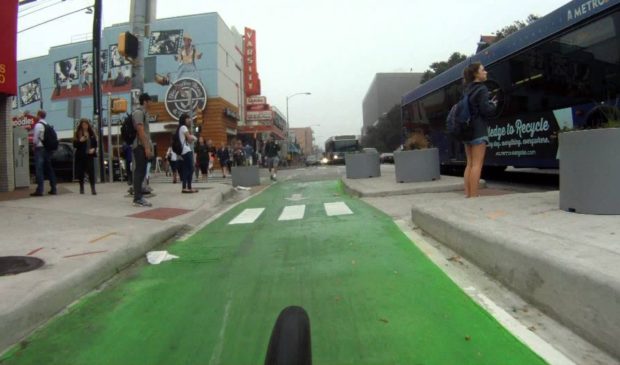Newsletter Signup
The Austin Monitor thanks its sponsors. Become one.
Most Popular Stories
- Austin opens new affordable housing development in Southeast Austin
- Landmark commission says goodbye to Nau’s Enfield Drug
- Congress Avenue transformation plan gets support from Urban Transportation Commission
- After a decline last year, Travis County homeowners should expect a return to rising property taxes
- ZAP Commission forwards recommendation allowing some commercial uses in residential zones
-
Discover News By District

Corridor studies offer potpourri of proposals along arterials
Tuesday, May 31, 2016 by Caleb Pritchard
On Wednesday, City Council will formally hear the results of a monthslong assessment of public opinion on transportation priorities, which is aimed at providing guidance for crafting a bond proposal this November.
However, Mayor Steve Adler jumped the gun last week by offering his own vision for a referendum he wants to put before voters.
“We need to focus on our major streets,” Adler told the Greater Austin Chamber of Commerce at a private event on Thursday. “The planners call them ‘corridors,’ but we know of them as the parking lots formerly known as North and South Lamar, Airport Boulevard, Guadalupe, Riverside, Burnet, MLK East/FM 969.”
The mayor called for a $720 million bond package that would fund projects identified in the several studies conducted by city staff on those major arterials. Interestingly, most of those studies were themselves born out of a 2010 bond package worth $90 million.
“The corridor programs really are the city’s attempt to go back and look at roads that were originally designed decades ago for a certain purpose and modernize them to allow the people who want to use them (to do so) in a variety of ways,” Austin Department of Transportation representative Cheyenne Krause told the Austin Monitor on Friday.
ATD staff members have completed five studies so far and are currently working on a sixth, the ambitious reimagining of Guadalupe Street from MLK Boulevard to 29th Street. The draft version of the study calls for the dedication of one travel lane in each direction to transit and right-turning cars.
The other studies aim for significantly less disruption to the status quo.
“The designs include a ‘do no harm’ policy to the current capacity to carry cars,” ATD Assistant Director Gordon Derr told the Monitor. In some cases, he said, the plans would add dedicated turning lanes at intersections.
Indeed, much of the studies’ focus lands on intersections, and many of the short-term goals identified in each study call for new signals, turn lanes and improvements to signal timing. However, they also endorse improvements to sidewalks and to bicycle and transit facilities. In his speech on Thursday, Adler told his Chamber audience four separate times that those enhancements will get obstructions “out of your way, and you keep going.”
He also said that the plans have been “sitting on a shelf,” a claim that’s not fully accurate, according to Derr. “We haven’t really implemented any of the medium- or long-term ideas, but we have moved forward with some of the short-term recommendations,” he said.
Examples of those include the installation of traffic signals on FM 969 at State Highway 130 and the recent addition of a signal at South Lamar Boulevard and Toomey Road.
While funding for each proposed project could be provided in small installments over the years, the mayor’s bond proposal would, in effect, accelerate the implementation of the plans.
There remains, however, a significant barrier: Many of the corridors in question are, in fact, controlled by the Texas Department of Transportation. That includes Airport Boulevard from Manor Road to U.S. Highway 183, South Lamar from Panther Trail to Ben White Boulevard, North Lamar from U.S. 183 to Interstate 35 (the entirety of the stretch covered by the corridor study), Burnet Road from U.S. 183 to MoPac Expressway, and the entire FM 969 corridor from U.S. 183 to the Village of Webberville in eastern Travis County.
Conveniently for Adler’s proposal, in a speech several hours before the mayor’s address, state Sen. Kirk Watson suggested a plan by which the city would take control of those roads in exchange for funding projects along I-35.
“It would shorten the time and the cost considerably if they were actually under our control,” Derr told the Monitor.
Adler claimed that funding the various projects in the corridor studies would cost between $450 million and $550 million. That lower figure aligns with an estimate penciled out by ATD staff last year. It would also take the lion’s share of the mayor’s $720 million proposal.
In another stroke of convenience for the mayor, of the roughly 7,000 people who participated in the Mobility Talks public input process — the survey whose findings Council will hear on Wednesday — a plurality of 46 percent endorsed the funding of corridor improvements over local or regional needs. However, 75 percent also said they want to use alternatives to cars more often, which suggests a boost for competing proposals to the mayor’s, including Bike Austin’s call for funding the 2014 Bicycle Master Plan and high-priority sidewalks.
Council will not take action on the Mobility Talks briefing on Wednesday, but the Mobility Committee could make a recommendation after a scheduled public hearing on June 14.
Image from YouTube
You're a community leader
And we’re honored you look to us for serious, in-depth news. You know a strong community needs local and dedicated watchdog reporting. We’re here for you and that won’t change. Now will you take the powerful next step and support our nonprofit news organization?








